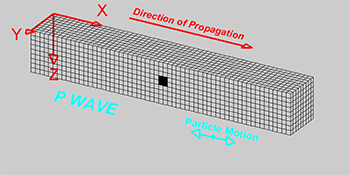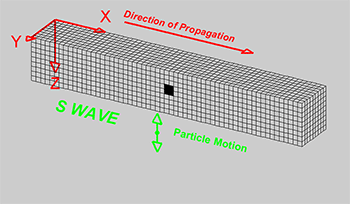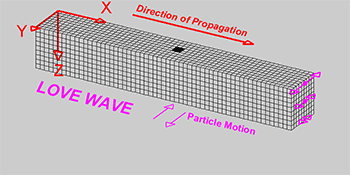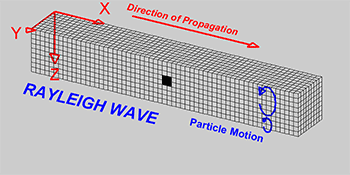Seismic Waves That Can Move Through Solids, Liquids, and Gases Are
Earthquakes and underground explosions can release a lot of free energy. That energy ripples abroad from its source in a variety of ways. Some of those vibrations will move frontward and back through the material they travel through . Other waves travel just like ocean waves, where they make the material they laissez passer through motion up and downward compared to the direction the moving ridge is traveling. And while some of these waves travel deep within the planet, even so others move only along the surface. Studying where these various flavors of waves are and how they motility not only can help scientists pinpoint where an earthquake or explosion occurred, but too can shed light on the construction of our inner planet.
Seismic waves are vibrations in the footing. These can be generated by a number of phenomena, including earthquakes, hush-hush explosions, landslides or collapsing tunnels inside a mine. There are four major types of seismic waves, and each typically travels at different rates of speed. That's ane big reason why scientists are able to tell them apart. If the waves arrived at vibration-detecting instruments — seismometers (Sighs-MAH-meh-turz) — all at the aforementioned time, it would be difficult to tell them apart.
Another major difference between these types of waves is how a cloth will move as the wave passes through it. With these differences in mind, permit's review the major types of seismic waves.
P versus S waves
Seismologists are scientists who study earthquakes. They also study how a quake's energy spreads through World'southward crust, as well as the deeper layers of our planet. The fastest seismic waves are known every bit P waves. That "p" stands for master. And early seismologists called them that considering these waves were the first to get in at seismometers from some distant quake.

At Earth's surface, P waves travel somewhere between 5 and 8 kilometers per 2nd (iii.1 and 5 miles per 2nd). Deeper within the planet, where pressures are higher and cloth is typically more dense, these waves can travel upwards to 13 kilometers per 2d (8.ane miles per 2nd).
P waves travel through rock the same fashion that audio waves do through air. That is, they movement as pressure waves. When a pressure moving ridge passes a certain point, the cloth it is passing through moves forward, then back, forth the same path that the moving ridge is traveling.
P waves can travel through solids, liquids and gases. That's 1 big difference between them and the other types of seismic waves, which typically travel just through solids (such equally rock).
The adjacent-fastest blazon of seismic waves are "secondary." They earned that name because they were typically the second set to reach seismometers from a distant quake. Not surprisingly, they're known as Southward waves.

In general, Due south waves are just 60 percent as fast as p waves. So, forth Globe's surface they motion at speeds of between three and 4.viii kilometers per second (one.9 and 3 miles per second).
Every bit an S wave passes through a material, the site of its passing moves from side to side or up and down (as compared to the direction the wave is traveling). This is why S waves are as well known every bit transverse waves. "Transverse" comes from the Latin words for "turned across.")
Southward waves cannot travel through liquids or gases. That'south because the types of stresses set up by those waves can only be transmitted through solid materials.
Distinguishing earthquakes from nuclear shakes
Because P waves and S waves travel through Earth — not just along its surface — they are also known as "body waves." This trait makes them useful in a number of ways. For one, scientists tin use P waves and South waves to identify where an convulsion began. To exercise that, they need to accept data gathered by seismic instruments at three or more different locations. That lets them triangulate to find the source of Earth's shimmying.
Triangulation is only possible when there are authentic measurements of the times at which P waves and Southward waves show up at each seismometer. Some techniques utilize only the P waves. Others likewise consider the time departure betwixt the arrival of the beginning P waves and S waves. (The further the altitude between the seismometer and the source of the quake, the more exaggerated that time difference will be.)
Whatever method is used, information technology gives scientists only an gauge of how far from a seismometer the convulsion'south source happens to be. Then with a seismometer every bit a center, scientists draw a circle of the proper size on a map. Just using only 1 seismometer, there is no way to tell in which management the source was. It could be anywhere along the outer edge of that circle. Past plotting the circles for at least three instruments on the same map, however, there will be a single point where those circles overlap. That marks the point on Earth's surface above the quake site.
Nigh quakes occur deep within World's crust. The point where a quake originates is chosen its hypocenter. The bespeak on Globe's surface straight above the hypocenter is the quake'due south epicenter.
But scientists don't just apply these waves to map earthquakes. Those same seismic waves as well tin can be generated past underground explosions. These might arise from a small blast inside an underground coal mine, for instance. Or, they might signal the test detonation of a nuclear weapon (such as several that recently took identify in Democratic people's republic of korea). And P waves, in particular, tin strongly point to whether the seismic waves come from a natural convulse or an unnatural blast.
Here'south why: When a natural convulsion occurs, one side of a fault zone slides in one direction; the other side slides in the contrary fashion. (A fault zone is a fracture in Earth's crust, or a boundary between ii tectonic plates, where slippage can occur and seismic free energy can be released.) Now, imagine that an earthquake occurs in an surface area that'south covered with a network of seismometers. For some of the instruments, the first P waves to arrive will be a "push" from the quake. Just for others, the first P waves to arrive volition exist a "pull."
For seismic vibrations generated by an unnatural explosion, the first P wave to make it at every seismometer will provide a "push." Non only that, the P waves generated by an unnatural explosion are typically precipitous and sudden. So they die away pretty rapidly. Vibrations produced by a natural earthquake instead tend to rumble for quite a while. That's because the slippage along mistake zones in a natural quake doesn't happen all at in one case, like an explosion does.
Even so more flavors of seismic waves
At starting time, all of a quake's energy travels from its source deep inside the planet as P waves and S waves. But when that energy reaches the surface, it at present tin spread as either of ii different types of waves.

Recall of a quake's free energy as a bubble rising from the lesser of a swimming. The surface waves are much like the ripples in the pond'south surface. Here, the waves spread from the quake'southward epicenter. These waves also are typically larger and cause much more damage than P waves and S waves.
The faster of these surface waves was named after British mathematician A.Eastward.H. Love. More than 100 years ago, he worked out the math that explains how such waves move. The second blazon of surface waves were named for a British physicist who, in the 1880s, predicted their being. This scientist was named John William Strutt. His begetter had been a British noble dubbed Lord Rayleigh. At his begetter's death in the 1870s, Strutt inherited the title, condign the side by side Lord Rayleigh. The waves he predicted are now known as Rayleigh waves.
Of these ii surface waves, the Love type travels a scrap faster.

Similar South waves, Love waves milkshake the ground from side to side compared to the direction they're headed. (In other words, for a Dearest wave traveling n, the footing shakes back and forth from east to west.) Rayleigh waves, on the other hand, cause ground movements in 2 directions at one time. One of those motions is up and down, very much like waves on the ocean's surface. The other is a push-pull motion along the aforementioned path that the wave is traveling. Together, those motions generate a rolling action that can cause extreme damage to buildings and other structures.
Other uses for seismic waves
Geoscientists often use seismic waves to map details of the inner structure of our planet. For instance, the fourth dimension it takes P waves and S waves to travel downward into Earth and and then return to the surface helps scientists calculate how deep the boundaries of World's major layers are. (Those calculations are fabricated possible, in large part, because researchers accept measured the speed of seismic waves through rocks under immense pressure in the lab.)
P waves and Due south waves tell scientists a lot more than the depth ranges of Globe'southward major layers. In some cases, they also provide strong clues about the type and density of materials in those layers. For instance, at distances of between eleven,570 and 15,570 kilometers (vii,190 to 9,670 miles) from a major earthquake, seismometers don't record whatever S waves coming direct from that convulse. That's a big clue that Globe's outer core is made of liquid, scientists say. (In areas more than fifteen,570 kilometers away from a quake'due south epicenter, seismometers do detect S waves. Those waves develop when the energy of P waves that take traveled through Earth'southward outer core once once more enter the generally solid mantle. That's the very thick layer that lies between Earth's outer cadre and its chaff.)
At shallow depths in Earth's crust, all types of seismic waves can exist used to map out relatively small-scale geological structures. These include things such equally faults and sediment-filled basins. (Sediment-filled basins are broad bowls of solid rock where loose material accumulates. Such areas can be especially affected by earthquakes. That's considering seismic waves tin can get trapped and bounce around inside that basin, making the sediment milkshake like jelly in a bowl.) Again, the time information technology takes for a seismic wave to travel to a construction then echo back helps scientists judge how far abroad that structure is.
Fifty-fifty people setting off modest explosions of dynamite can trigger seismic waves. That means these can be mapped from afar. It'due south also possible to use data gathered by seismometers over a long menstruation of fourth dimension. Although such signals may be faint, they tin exist assembled into stronger signals (much in the same way that photographers can take photos in dim light past leaving their camera'due south shutter open for minutes or even hours at a time).
More Stories from Science News for Students on Earth
Source: https://www.sciencenewsforstudents.org/article/explainer-seismic-waves-come-different-flavors
Post a Comment for "Seismic Waves That Can Move Through Solids, Liquids, and Gases Are"